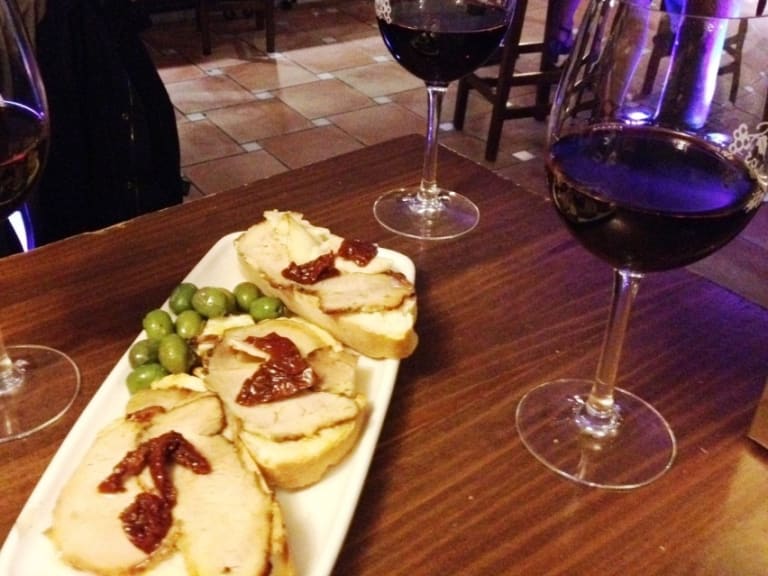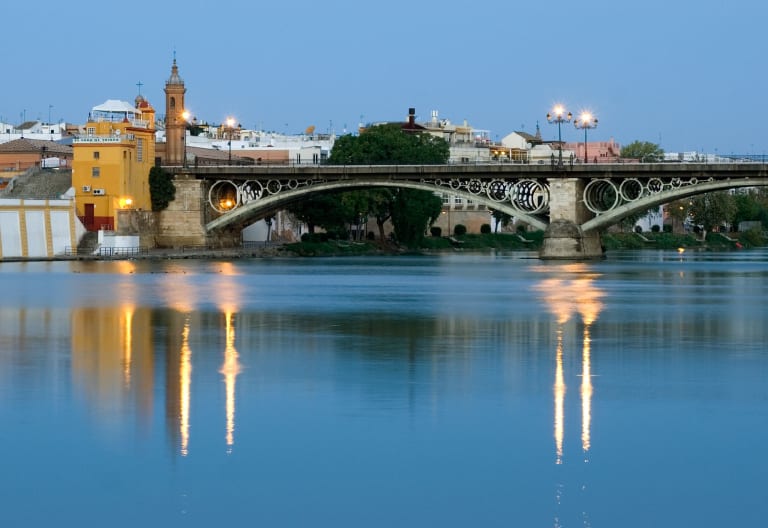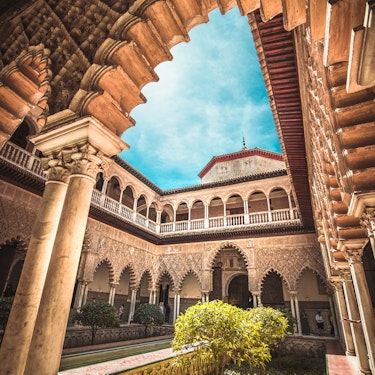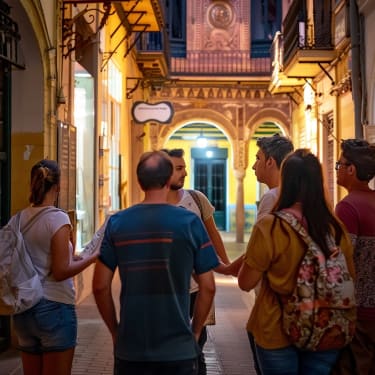More about: 10 Best Things to Do In Triana In Seville
Although the Andalusian capital is not on the coast, during the Golden Age it was the most important port in Spain. Indeed, the famous expedition of Magellan and Elcano set sail from the docks of Triana.
This neighbourhood on the banks of the Guadalquivir is also known for its flamenco tradition, its tapas bars and for being the departure point for river cruises. There is no doubt that visiting it is one of the essential things to see and do in Seville.
1. Stroll around the Castle of San Jorge

The fortress is located just across the Isabel II Bridge (also known as the Triana bridge) and has stood guard over the river since the time of the Visigoths. Its origins are somewhat uncertain although it is thought to have been erected to defend the city from the attacks of Leovigild, a Gothic king who distinguished himself by his successful military campaigns.
The Castle of San Jorge reached its peak during the 15th century, the so-called "Golden Age". Indeed, the Inquisition established its headquarters in the fortress in 1481 and occupied its premises until 1785.
Part of St. George's Castle was demolished in the 19th century, and what remains houses a centre for the interpretation of the ruins and religious repression.
Practical information
- Address: Plaza del Altozano s/n
- Timetables: Tuesday-Saturday, 10am-1:30pm and 5-7:30pm. On Sundays and public holidays it is open from 10:00 to 13:30.
- Price: admission is free
2. Admire the best dancers in town

If you are looking for a flamenco show in Seville, you are in the right neighbourhood. It is said that the inventors of this art form resided in Triana as it was home to a large gypsy community. To play it safe I recommend you head to the Teatro Flamenco Triana which **won TripAdvisor's "Travelers' Choice" in 2020.
There are daily shows at two times: 19:30 and 21:00. The building is located at Calle Pureza 76, a short walk from the Guadalquivir and the Capilla de los Marineros. If you can't find a seat you can opt for other tablaos such as Teatro Pura Esencia Flamenco (Calle Betis 56) and Baraka (Calle Pureza 107).
3. Discover the patios of Triana

This neighbourhood has the largest number of patios and corralas in Seville. They are very pretty and have the typical Andalusian charm. They cast shade and are dotted with climbing plants and vases.
On some occasions, the city council organises visits to eight courtyards in Triana: Cerca Hermosa, Corral de Los Corchos, Casa Quemada, Hotel Triana, Corral Largo, Patio de las Flores, Corral San Jorge and Corral de la Encarnación. This event usually takes place during the autumn.
4. Prepare a tapas route

Tapas is a way of life in Andalusia and its capital is no exception. Triana is home to an endless number of bars and taverns where you can eat well without spending an arm and a leg and the list below reveals the best:
- Casa Ruperto, the temple of quails. It is a simple bar with a classic red awning and a white inscription. Its famous birds are bred in the province of Lérida and I assure you they are delicious. I also recommend you try the snail and cabrillas stew, a serranito or the pringá, a sandwich made with the meat from the stew (Avenida Santa Cecilia 2).
- Bar Juan Carlos, a cheesemonger's paradise. Its range of dairy products is impressive - there are more than 100 varieties - and is complemented by game pâtés, cecina, Galician-style octopus and other delicacies. It also stands out for its excellent national and international beers (Calle Febo 6).
- Freiduría Reina Victoria, the ideal place to eat cod in batter as well as baby squid, marinated fish, squid and much more. It is a simple establishment with spacious rooms and affordable prices (Calle Rodrigo de Triana 51).
- Bar Salomón, the place to go for pinchos and grilled meats (Calle López de Gómara 11).
- Las Golondrinas, a must in Triana. There are two bars under the same name: the first is more traditional while the second has a contemporary style. Its specialities are sirloin tips, grilled mushrooms, Iberian cheeks and caballitos de jamón, fried slices of bread topped with succulent ham (Calle Pagés del Corro).
- Blanca Paloma, a neighbourhood classic. Its fame is due to the bocaditos de mejillones, very tasty seafood croquettes. Other dishes to try are the aubergines stuffed with prawns, anchovies or potatoes seasoned with mackerel ( Calle San Jacinto 49).
5. Sail on the Guadalquivir

The Guadalquivir is the only navigable river in Spain. Its placid waters are the lure for thousands of Sevillians and tourists who come to the banks to canoe, take a stroll or go on a river cruise.
Most of the boat trips on the Guadalquivir leave from Triana. A few minutes after setting sail, the cruises pass under a Seville icon, the Isabel II Bridge.
They are not usually very long trips as they focus on the navigable canal built during the reign of Alfonso XIII. Depending on the amount paid, you will be entitled to a drink (glass of wine, beer, soft drink, etc.).
However, a new practice has been gaining popularity in recent years. Naturally I'm talking about Paddle Surf or SUP, a discipline that consists of moving on a surfboard upright, propelling each movement with a paddle. This sport was born in the sixties in Polynesia and little by little it has been gaining followers in other continents.
Balance is essential but with a little practice you will be able to move easily and develop your muscles at the same time. In Triana you can opt for Sup Guadalquivir (Mercado de Triana stall 29) or Paddle Surf Sevilla (Calle Betis 19).
6. Visit the Ceramics Centre

The pottery industry is doubly linked to Triana. Pottery production was concentrated in this part of the city and the centre in Calle Antillano Campos brings the craft tradition back to life.
You'll learn the trade and see the 16th century kilns and a selection of stylish and colourful pieces.
The Ceramics Centre is located behind the Triana Market and is open from 11:00 to 18:00 (Tuesday to Saturday) and from 10:00 to 15:00 (Sundays and public holidays). The price is very affordable - around 2 € - and therefore worth a little time.
7. Book a tour of mysteries and legends

Triana is home to the Castillo de San Jorge, a fortress that was the seat of the Inquisition from the 15th to the 18th century.
Behind its walls confessions were extorted using very unorthodox methods and many were killed after bloody torture. The fort is shrouded in a web of legends that you can discover by booking a night-time tour of Seville.
It is not only the castle that is the protagonist of this story. Guided tours will take you to other parts of the neighbourhood such as the Patio de Monipodio, Calle Pagés del Corro (the old Cava) or the Chapel of the Virgen del Carmen. Triana is linked to the birth of flamenco and maritime voyages, and there is no shortage of stories to tell.
Practical information
- Duration: 1 hour and a half
- Price: around 10 €.
8. Relax on a terrace

Triana is located on the banks of the Guadalquivir and its tallest buildings overlook the old town. Thanks to its privileged position, it enjoys incomparable views over Seville. If you travel to the capital of Seville in summer you can escape the heat in the terraces of the neighbourhood.
Here are some options on the heights (or not) that will take your breath away:
- María Trifulca, the restaurant of the Sevillian jet set. It's not unusual to see a footballer or other famous person and it's not surprising. It has a wide selection of dishes based on fresh fish and seafood such as the delicious white prawns or red tuna delicacies. There are also meat options as well as pastas, rice dishes and other delicacies. From its terrace you can admire the narrow streets of Triana, the Cathedral and the bullring (Plaza del Altozano 1).
- Puerto de Cuba, the Mecca of the cocktail bar. Its terrace over the water is a privileged viewpoint overlooking the Torre de Oro and the ideal place to start the night with a drink (Calle Betis s/n).
- Hotel Ribera de Triana, the perfect choice to treat yourself. You don't have to have a room to enjoy LEVEL 5th, a bar with a panoramic terrace, solarium and swimming pool. Its designer tables and loungers and the captivating blue light create an exclusive and relaxing space (Plaza de Chapina s/n).
- Betis 7 Triana Experience, a restaurant a stone's throw from the Isabel II Bridge. Its recipes reinterpret the Andalusian tradition by adding touches of the East, Italy and other world cuisines. To extend the evening and continue enjoying the view, you can order a caipirinha or a Martini (Calle Betis 7).
9. Relive history in Calle Betis

This street runs parallel to the river and its origins date back to the 18th century when a great wall was built to contain the floods of the Guadalquivir. What today is a busy destination for canas and tapas, in the past was bustling with sailors, merchants and admirals.
On this same street was the Universidad de Mareantes, a school that trained the crews that travelled between Seville and the Americas. Today there is no trace of it, but in its place stands the Casa de las Columnas, an elegant building that today houses a civic community centre. A ceramic plaque commemorates
Take the time to stroll around admiring the colourful facades of the houses and the view across the river. By the way, if you are interested in viewpoints I recommend you to read the post about the best views of Seville.
10. Enter the Church of Santa Ana

At the crossroads between the streets Pureza, Vázquez de Leca, Bernardo Guerra and Pelay Correa stands a temple with more than seven centuries of history. It was built during the 13th century and was originally located outside the walls.
After the reconquest, the subsequent arrival of the Spaniards in America and the Lisbon earthquake, everything changed suddenly.
The Baroque aspect gave way to the mixture of Mudejar and Gothic that we can see today and the men returning from the colonies.
If you travel to Seville at the end of July you can enjoy its main event: the Novena to Señora Santa Ana. A tip: just a few metres from the church you will find De Triana, a shop with clothes, accessories and objects related to this traditional neighbourhood.
How much time do you need to visit Triana?

In my opinion, you should dedicate at least half a day to it. It is a very charming neighbourhood and it is worth taking your time to visit it. As it is a very famous destination for tapas tours, you can arrive at lunchtime and burn off a few calories with a stroll along the banks of the Guadalquivir.
















